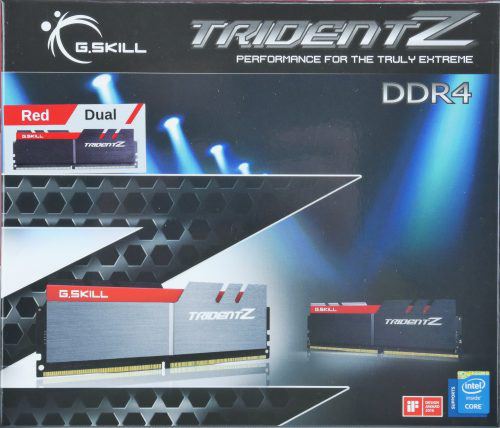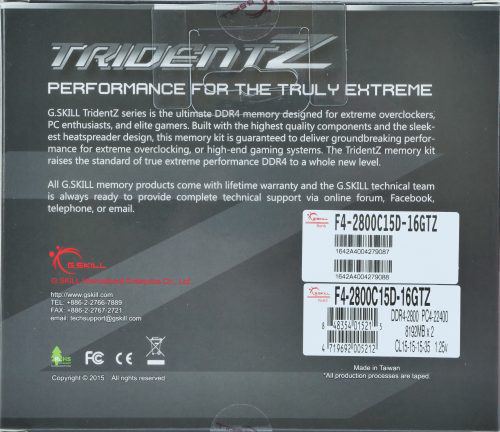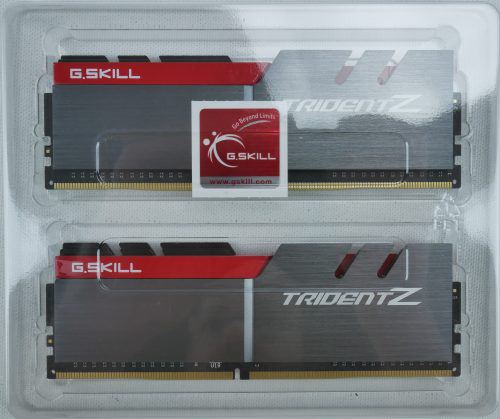Test – G.Skill DDR4 2 x 8 Go 2800 MHz TridentZ
| Specs | Price
Hi all!
We are continuing the testing of products from G. Skill, this time it will be what the brand has been known for for a very long time now, memory. I am going to present to you a DDR4 kit which has the sweet name F4-2800C15D-16GTZ!
Not easy to know exactly what we are talking about here 😛 This is a 2 X 8 GB kit clocked at 2800 MHz and from the TridentZ family, which represents the high end of the brand at the moment. The range is quite wide, going from 2800 MHz to 4266 MHz, so clearly performance oriented. Offered at a price of around 110 € and taking into account the increase in the price of the memory at the time of this writing, the kit fits well, let’s see what this gives in practice!
| G.Skill DDR4 TridentZ 2 X 8 Go 2800 MHz | |
|---|---|
| Model reference | F4-2800C15D-16GTZ |
| Type of memory | DDR4 |
| Number of bars | 2 |
| Total capacity | 16 Go |
| Heat sink | TridenZ Gray and black |
| SPD speed | 2133 MHz |
| SPD latency | 15-15-15-35 |
| Tension SPD | 1.2V |
| Speed tested | 2800 MHz |
| Latency tested | 15-15-15-35 |
| Voltage tested | 1.2V |
| Performance profile | XMP 2.0 |
| Guarantee | Limited lifetime |
| Price | ~ 110€ |
The G.SKill TridentZ 2 X 8 GB 2800 MHz kit is of course sold to operate in “Dual Channel”, mainly on 1151 sockets (and Z170 chipset). The heatsinks are two-tone, gray on one side and black on the other, with a little red to make the whole thing a little more “gamer”.
Compatibility requires the modules to have a base rate (or SPD) of 2133 MHz for latencies of 15-15-15-36 at a voltage of 1.2V, which should ensure full compatibility with all motherboards. In order to reach the rates for which the kit has been tested, the XMP 2.0 profile is present, ensuring a frequency of 2800 MHz for latencies of 15-15-15-35 at a voltage of 1.2V. The latencies are therefore tight while keeping the “base” voltage of DDR4, which is a very good thing. Note that all memory modules exceeding 2133 MHz are considered overclocked, since the memory controllers integrated into Intel processors operate at this frequency.

The front of the box offers photos of the memory strips, on both sides to show the 2 different colors. In addition to this, of course, we find the logo of the brand and the model, nothing more!

At the back, a little marketing spiel is present, saying that the TridentZ is made for those looking for “ultimate” memory to overclock, or for “elite” players .. in short, let’s move on 😀 There are also labels showing the technical characteristics of the kit, frequency, latencies, voltage etc.

Inside the box is the kit enclosed in a plastic mold, which should ensure a minimum of safety during transport.

Here are the beasts! As we can see the design is unique here. The radiators are made of aluminum, gray on one side and black on the other, with a red border, this gives a rather nice effect, even if it remains in memory: p The build quality is excellent, there is no really has nothing to say about it.
The radiators exceed the PCB, it will therefore be necessary to pay attention to the choice of the cooler so as not to end up in a plan because of the memory modules too high.

A label is present on each bar, it contains the complete technical characteristics, such as the model reference, frequency, latencies etc.
![]()
On the top we can see the red border crossing the radiator, the logo of the brand is in its center. At least everyone will be able to see where the memory is coming from in a windowed configuration.

Note that unlike DDR3 DDR4 strips do not have a straight PCB at the pins, in the center the pins are longer than at the sides, there may be a practical reason for this, such as a drop breakage during installation, I could not say!















